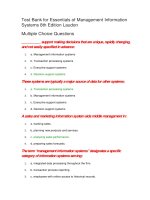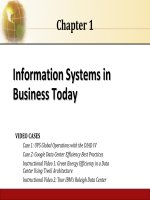Management information systems 13th laudon chapter 02
Bạn đang xem bản rút gọn của tài liệu. Xem và tải ngay bản đầy đủ của tài liệu tại đây (993.34 KB, 39 trang )
Chapter 2
Global E-business and
Collaboration
VIDEO CASES
Case 1: Walmart’s Retail Link Supply Chain
Case 2: Salesforce.com: The Emerging Social Enterprise
Case 3: How FedEx Works: Inside the Memphis Hub
Instructional Video 1: US Foodservice Grows Market with Oracle CRM on Demand
Management Information Systems
Chapter 2: Global E-business and Collaboration
Learning Objectives
• Define and describe business processes and
their relationship to information systems.
• Evaluate the role played by systems serving
the various levels of management in a
business and their relationship to each other.
• Explain how enterprise applications improve
organizational performance.
2.2
Copyright © 2014 Pearson Education, Inc.
Management Information Systems
Chapter 2: Global E-business and Collaboration
Learning Objectives (cont.)
• Explain the importance of collaboration and
teamwork in business and how they are
supported by technology.
• Assess the role of the information systems
function in a business.
2.3
Copyright © 2014 Pearson Education, Inc.
Management Information Systems
Chapter 2: Global E-business and Collaboration
TELUS Embraces Social Learning
• Problem: Need to capture employee knowledge as 40% of
workforce nears retirement
• Solutions: New technology for collaborative knowledge
sharing
• Microsoft SharePoint Server 3010 provided companywide
platform for collaboration, knowledge acquisition and
transfer, and social tools
• Demonstrates IT’s role in collaboration and documenting
knowledge
• Illustrates the need for changing organizational culture and
business processes to use information systems effectively
2.4
Copyright © 2014 Pearson Education, Inc.
Management Information Systems
Chapter 2: Global E-business and Collaboration
Business Processes and Information Systems
• Business processes:
– Flows of material, information, knowledge
– Sets of activities, steps
– May be tied to functional area or be crossfunctional
• Businesses: Can be seen as collection of
business processes
• Business processes may be assets or liabilities
2.5
Copyright © 2014 Pearson Education, Inc.
Management Information Systems
Chapter 2: Global E-business and Collaboration
Business Processes and Information Systems
• Examples of functional business processes
– Manufacturing and production
• Assembling the product
– Sales and marketing
• Identifying customers
– Finance and accounting
• Creating financial statements
– Human resources
• Hiring employees
2.6
Copyright © 2014 Pearson Education, Inc.
Management Information Systems
Chapter 2: Global E-business and Collaboration
The Order Fulfillment Process
FIGURE 2-1
2.7
Fulfilling a customer order involves a complex set of steps that requires the close coordination of the sales,
accounting, and manufacturing functions.
Copyright © 2014 Pearson Education, Inc.
Management Information Systems
Chapter 2: Global E-business and Collaboration
Business Processes and Information Systems
• Information technology enhances business
processes by:
– Increasing efficiency of existing processes
• Automating steps that were manual
– Enabling entirely new processes
• Change flow of information
• Replace sequential steps with parallel steps
• Eliminate delays in decision making
• Support new business models
2.8
Copyright © 2014 Pearson Education, Inc.
Management Information Systems
Chapter 2: Global E-business and Collaboration
Types of Information Systems
• Transaction processing systems
– Serve operational managers and staff
– Perform and record daily routine transactions
necessary to conduct business
• Examples: sales order entry, payroll, shipping
– Allow managers to monitor status of operations
and relations with external environment
– Serve predefined, structured goals and decision
making
2.9
Copyright © 2014 Pearson Education, Inc.
Management Information Systems
Chapter 2: Global E-business and Collaboration
A Payroll TPS
A TPS for payroll processing
captures employee payment
transaction data (such as a
time card). System outputs
include online and hard-copy
reports for management and
employee paychecks.
FIGURE 2-2
2.10
Copyright © 2014 Pearson Education, Inc.
Management Information Systems
Chapter 2: Global E-business and Collaboration
Types of Information Systems
• Business intelligence
– Data and software tools for organizing and analyzing data
– Used to help managers and users make improved
decisions
• Business intelligence systems
– Management information systems
– Decision support systems
– Executive support systems
2.11
Copyright © 2014 Pearson Education, Inc.
Management Information Systems
Chapter 2: Global E-business and Collaboration
Interactive Session: Technology
CAN AIRLINES SOLVE THEIR BAGGAGE HANDLING PROBLEMS?
Read the Interactive Session and discuss the following questions
• What types of transactions are handled by baggage handling
systems?
• What are the management, organization, and technology
components of baggage handling systems?
• What is the problem these baggage handling systems are
trying to solve? Discuss the business impact of this problem.
Are today’s baggage handling systems a solution to this
problem?
• What kinds of management reports can be generated from
the data from these systems?
2.12
Copyright © 2014 Pearson Education, Inc.
Management Information Systems
Chapter 2: Global E-business and Collaboration
Types of Information Systems
• Management information systems
– Serve middle management
– Provide reports on firm’s current
performance, based on data from TPS
– Provide answers to routine questions with
predefined procedure for answering them
– Typically have little analytic capability
2.13
Copyright © 2014 Pearson Education, Inc.
Management Information Systems
Chapter 2: Global E-business and Collaboration
How MIS Obtain Their Data from the Organization’s TPS
FIGURE 2-3
2.14
In the system illustrated by this diagram, three TPS supply summarized transaction data to the MIS
reporting system at the end of the time period. Managers gain access to the organizational data through
the MIS, which provides them with the appropriate reports.
Copyright © 2014 Pearson Education, Inc.
Management Information Systems
Chapter 2: Global E-business and Collaboration
Sample MIS Report
FIGURE 2-4
2.15
This report, showing summarized annual sales data, was produced by the MIS in Figure 2-3.
Copyright © 2014 Pearson Education, Inc.
Management Information Systems
Chapter 2: Global E-business and Collaboration
Types of Information Systems
• Decision support systems
– Serve middle management
– Support non-routine decision making
• Example: What is the impact on production schedule if
December sales doubled?
– May use external information as well TPS / MIS data
– Model driven DSS
• Voyage-estimating systems
– Data driven DSS
• Intrawest’s marketing analysis systems
2.16
Copyright © 2014 Pearson Education, Inc.
Management Information Systems
Chapter 2: Global E-business and Collaboration
Voyage-Estimating Decision Support System
FIGURE 2-5
2.17
This DSS operates on a powerful PC. It is used daily by managers who must develop bids on shipping
contracts.
Copyright © 2014 Pearson Education, Inc.
Management Information Systems
Chapter 2: Global E-business and Collaboration
Types of Information Systems
• Executive support systems
– Support senior management
– Address non-routine decisions
• Requiring judgment, evaluation, and insight
– Incorporate data about external events (e.g. new tax
laws or competitors) as well as summarized
information from internal MIS and DSS
– Example: Digital dashboard with real-time view of firm’s
financial performance: working capital, accounts
receivable, accounts payable, cash flow, and inventory
2.18
Copyright © 2014 Pearson Education, Inc.
Management Information Systems
Chapter 2: Global E-business and Collaboration
Interactive Session: Technology
PILOTING PROCTER & GAMBLE FROM DECISION COCKPITS
Read the Interactive Session and discuss the following questions
• What management, organization, and technology issues
had to be addressed when implementing Business
Sufficiency, Business Sphere, and Decision Cockpits?
• How did these decision-making tools change the way
the company ran its business? How effective are they?
Why?
• How are these systems related to P&G’s business
strategy?
2.19
Copyright © 2014 Pearson Education, Inc.
Management Information Systems
Chapter 2: Global E-business and Collaboration
Types of Information Systems
• Enterprise applications
–
–
–
–
–
Systems for linking the enterprise
Span functional areas
Execute business processes across firm
Include all levels of management
Four major applications:
• Enterprise systems
• Supply chain management systems
• Customer relationship management systems
• Knowledge management systems
2.20
Copyright © 2014 Pearson Education, Inc.
Management Information Systems
Chapter 2: Global E-business and Collaboration
Enterprise Application Architecture
Enterprise applications
automate processes that span
multiple business functions
and organizational levels and
may extend outside the
organization.
FIGURE 2-6
2.21
Copyright © 2014 Pearson Education, Inc.
Management Information Systems
Chapter 2: Global E-business and Collaboration
Types of Information Systems
• Enterprise systems
– Collects data from different firm functions and stores
data in single central data repository
– Resolves problem of fragmented data
– Enable:
• Coordination of daily activities
• Efficient response to customer orders (production,
inventory)
• Help managers make decisions about daily operations
and longer-term planning
2.22
Copyright © 2014 Pearson Education, Inc.
Management Information Systems
Chapter 2: Global E-business and Collaboration
Types of Information Systems
• Supply chain management (SCM) systems
– Manage firm’s relationships with suppliers
– Share information about:
• Orders, production, inventory levels,
delivery of products and services
– Goal:
• Right amount of products to destination with
least amount of time and lowest cost
2.23
Copyright © 2014 Pearson Education, Inc.
Management Information Systems
Chapter 2: Global E-business and Collaboration
Types of Information Systems
• Customer relationship management
systems:
– Provide information to coordinate all of the
business processes that deal with customers
• Sales
• Marketing
• Customer service
– Helps firms identify, attract, and retain most
profitable customers
2.24
Copyright © 2014 Pearson Education, Inc.
Management Information Systems
Chapter 2: Global E-business and Collaboration
Types of Information Systems
• Knowledge management systems (KMS)
– Support processes for capturing and applying
knowledge and expertise
• How to create, produce, deliver products and
services
– Collect internal knowledge and experience within
firm and make it available to employees
– Link to external sources of knowledge
2.25
Copyright © 2014 Pearson Education, Inc.









